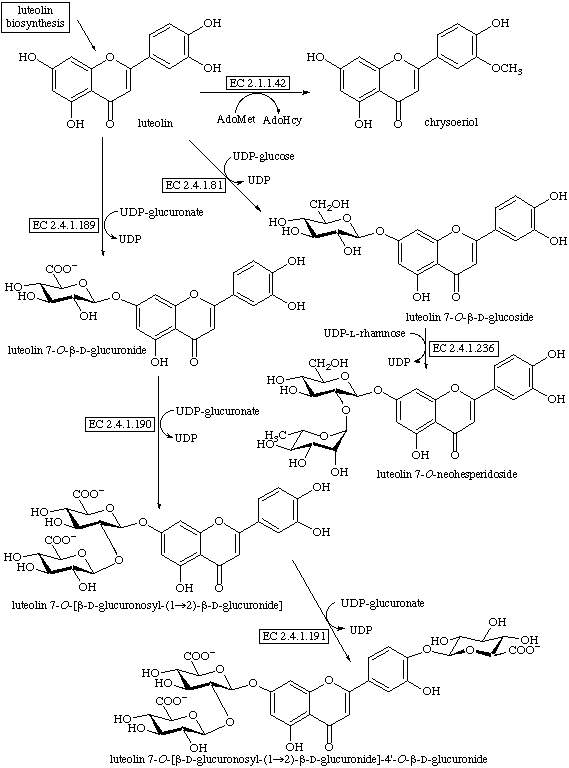
Luteolin, a flavonoid compound commonly found in fruit and vegetables, has been found to be able to surppress the activity of cell signaling pathways (IGF and PI3K) that play key roles in growth of cancer cells.

LUTEOLIN
The study, published in BioMed Central’s open access journal BMC Gastroenterology, suggested the possibility of developing novel therapies based on the plant flavonoid Luteolin against colon cancer, the second most frequent cause of cancer-related death in the Western World. Colon cancer cells have elevated levels of IGF-II compared to normal colon tissues.
Luteolin, commonly found in green peppers, carrots, olive oil, rosemary, peppermint, oranges and celery, has been shown by preclinical studies to have anti-inflammatory, anti-oxidant, antimicrobial, and anticancer activities. Earlier studies have found that luteolin could inhibit angiogenesis, induce apoptosis and affect carcinogenesis in animal models, suggesting the possibility to use this flavonoid as cancer chemopreventive and chemotherapeutic agent.
A group of Korean scientist performed studies that show that luteolin inhibits the secretion of IGF-II by colon cancer cells and within two hours decreased the amount of receptor (IGF-IR) precursor protein. Luteolin also reduced the amount of active receptor (measured by IGF-I dependent phosphorylation).
It is noted in the publication that luteolin “downregulates the activation of the PI3K/Akt and ERK1/2 pathways via a reduction in IGF-IR signaling in HT-29 cells; this may be one of the mechanisms responsible for the observed luteolin-induced apoptosis and cell cycle arrest”.
Colon cancer cells have elevated levels of IGF-II compared to normal colon tissues. It is thought that this is part of the mechanism driving uncontrolled cell division and cancer growth.
Prof Jung Han Yoon Park, the corresponding author of the publication, says “Our study, showing that luteolin interferes with cell signaling in colon cancer cells, is a step forward in understanding how this flavonoid works. A fuller understanding of the in vivo results is essential to determine how it might be developed into an effective chemopreventive agent”.
Luteolin is a yellow crystalline compound. It is a flavonoid; to be specific, it is one of the more common flavones.[1] From preliminary research, it is thought to play a role in the human body possibly as an antioxidant, a free radical scavenger, a promoter ofcarbohydrate metabolism, or an immune system modulator.[citation needed] If applicable to the human condition, these characteristics may inhibit cancer mechanisms. Basic research results indicate luteolin as an anti-inflammatory agent,[2] with other potential effects on septic shock.[citation needed] It has been suggested for multiple sclerosis on the basis of in vitro work.[3]
Luteolin acts as a monoamine transporter activator, and is one of the few chemicals demonstrated to possess this property.[4]
Natural occurrences
Luteolin can be found in Terminalia chebula. It is most often found in leaves, but it is also seen in rinds, barks, clover blossom, and ragweed pollen.[1] It has also been isolated from Salvia tomentosa.[5]
In food
Dietary sources include celery, green pepper, parsley, thyme, dandelion, perilla,chamomile tea, carrots, olive oil, peppermint, rosemary, navel oranges, and oregano.[6][7]
It can also be found in the seeds of the palm Aiphanes aculeata.[8]

- Mann, John (1992). Secondary Metabolism (2nd ed.). Oxford, UK: Oxford University Press. pp. 279–280. ISBN 0-19-855529-6.
- Johnson; Kelley, KW; Johnson, RW (May 2008). “Luteolin reduces IL-6 production in microglia by inhibiting JNK phosphorylation and activation of AP-1”. Proc. Natl. Acad. Sci. U.S.A. 105 (21): 7534–9. doi:10.1073/pnas.0802865105. PMC 2396685.PMID 18490655.
- Theoharides (2009). “Luteolin as a Therapeutic Option for Multiple Sclerosis”. Journal of Neuroinflammation 6 (1): 29.doi:10.1186/1742-2094-6-29. PMC 2768692. PMID 19825165.
- Zhao, G; Qin, GW; Wang, J; Chu, WJ; Guo, LH (2010). “Functional activation of monoamine transporters by luteolin and apigenin isolated from the fruit of Perilla frutescens (L.) Britt”. Neurochemistry international 56 (1): 168–76. doi:10.1016/j.neuint.2009.09.015.PMID 19815045.
- A. Ulubelen, M. Miski, P. Neuman, and T. J. Mabry (1979). “Flavonoids of Salvia tomentosa (Labiatae)”. Journal of Natural Products 42(4): 261–3. doi:10.1021/np50003a002.
- Kayoko Shimoi, Hisae Okada, Michiyo Furugori, Toshinao Goda, Sachiko Takase, Masayuki Suzuki, Yukihiko Hara, Hiroyo Yamamoto, Naohide Kinae (1998). “Intestinal absorption of luteolin and luteolin 7-O-[beta]-glucoside in rats and humans”. FEBS Letters 438 (3): 220–4. doi:10.1016/S0014-5793(98)01304-0. PMID 9827549.
- López-Lázaro M. (2009). “Distribution and biological activities of the flavonoid luteolin“. Mini Rev Med Chem. 9 (1): 31–59.doi:10.2174/138955709787001712. PMID 19149659.
- Lee, D; Cuendet, M; Vigo, JS; Graham, JG; Cabieses, F; Fong, HH; Pezzuto, JM; Kinghorn, AD (2001). “A novel cyclooxygenase-inhibitory stilbenolignan from the seeds of Aiphanes aculeata”. Organic letters 3 (14): 2169–71. PMID 11440571.












